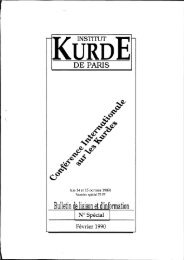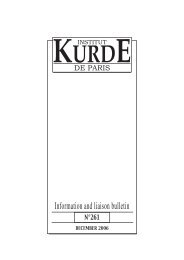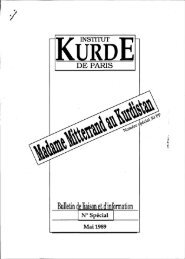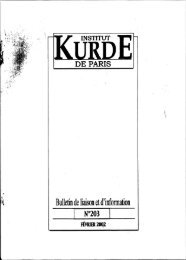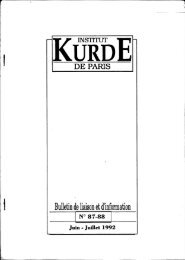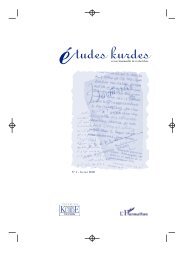Bulletin de liaison et d'information - Institut kurde de Paris
Bulletin de liaison et d'information - Institut kurde de Paris
Bulletin de liaison et d'information - Institut kurde de Paris
Create successful ePaper yourself
Turn your PDF publications into a flip-book with our unique Google optimized e-Paper software.
Revue <strong>de</strong> Presse-Press Review-Berhevoka Çapê-Rivista Stampa-Dentro <strong>de</strong> la Prensa-Basm Öz<strong>et</strong>i<br />
\Vho are the Kurds?<br />
The Kurds are the <strong>de</strong>scendants of Indo-European<br />
~ tribes who s<strong>et</strong>tled among the inhabitants of the<br />
Zagros mountains in various epochs, but probably<br />
mainly during the second millennium BC. The first<br />
mention of Kurds, as 'Cyrtii', occurred in the second<br />
century BC. At the time of the Arab conquest in the<br />
seventh century AD, the term 'Kurd' was used to<br />
<strong>de</strong>note nomadic people.<br />
The Kurds today, numbering at least 26 million,<br />
struggle to obtain political recognition. and rights as<br />
national communities within the state boundaries in<br />
which they find themselves. They form the largest <strong>et</strong>hnic<br />
community in th~ Middle East without a state of its own.<br />
Population estin1ates (1993) 0<br />
Country Total population Kurds %<br />
Iran 61,000,000 6,100,000 10%<br />
Iraq 19,300,000 4,400,000 23%<br />
Syria 13,400,000 1,100.000 8%<br />
Turkey 60,000,000 13,200.000 22%<br />
Former<br />
Sovi<strong>et</strong><br />
Union 500.000<br />
Elsewhere 700,000<br />
Total 26,000,000<br />
(OEstimates are in roun<strong>de</strong>d<br />
figures.)<br />
Where do the Kurds live?<br />
Although Kurds are to be found in Syria, the<br />
Caucasiëin republics of Armenia and Azerbaijan.<br />
Khorasan (in eastern Iran), and in Lebanon, the main<br />
concentration lives today where the Kurdish people<br />
have always lived - in the mountains where Iran, Iraq<br />
and Turkey me<strong>et</strong>. The heart of this area consists of the<br />
extremely' rugged mountains of the Zagros range.<br />
running in ridges north-west to south-east. In the west<br />
these mountain folds give way to rolling hills, and to<br />
the Mesopotamian plain. To the north the mountains<br />
slo\\'l)' turn to steppe-like plateau and the highlands of<br />
Anatolia. To the east the mountains fall awa\' to lowlands<br />
onto which the Kurds have also spread ..<br />
Although the population is not exdusivel~' Kurdish<br />
in much of this area, the dominant culture is Kurdish.<br />
From the earh' thirteenth centUl\" onwards much of<br />
this area has b~en called Kurdistan', although it \\'as not<br />
until the sixteenth centUT\', after the Kurds had moved<br />
nOlth and west onto th~ Anatolian plateau. th.lt tht'<br />
term Kurdistan came into common usage to <strong>de</strong>note ,\<br />
s\'stem of Kurdish fiefs. Since the)]. altli'~l\Ighthe tenn<br />
Kurdistan appears on few maps. it is dt'arl;' more than<br />
a geographkai krm siJl(:e it also refers to a human<br />
culture which exists in that ]an,!.<br />
Nevertheless no map of Kurdistan can be drawn<br />
without contention, and for this reason the <strong>de</strong>mographic<br />
map is not a political statement, but a statement<br />
of where large numbers of Kurds are found.<br />
Turkey for all practical purposes <strong>de</strong>nies Kurdistan's<br />
existence, while Iran and Iraq are reluctant to<br />
acknowledge that it is as extensive as many Kurds<br />
would have them accept.<br />
How do Kurds live?<br />
All Kurdish communities are stock-bree<strong>de</strong>rs mainly<br />
of sheep, goats and some cattle. In all parts of<br />
Kurdistan the cultivation of cereals is important,<br />
accounting for roughly 15 per cent of the total crop in<br />
Turkey, and 35 per cent and 30 percent respectively in<br />
Iran and Iraq. The principal cash crop o{the Kurdish<br />
foothills is tobacco, but it is of mo<strong>de</strong>rate quality and<br />
cannot comp<strong>et</strong>e in outsi<strong>de</strong> mark<strong>et</strong>s. Cotton is also<br />
grown, particularly in Anatolia. In the mountains, fruit<br />
and veg<strong>et</strong>ables are the main crops for local consumption.<br />
No more than a third of Kurdistan's arable land is<br />
actually cultivated, of which one third is always fallow.<br />
The major mineral in Kurdistan is oil, found in commercial<br />
quantities in Kirkuk and Khaniqin (Iraq),<br />
Batman and Silvan in Turkey and at Rumeylan in Syria.<br />
The exploitation of these oilfields by the respective<br />
governments heightens both the Kurdish sense of<br />
injustice and also governmental <strong>de</strong>termination to allow<br />
no separatism to threaten these important resources.<br />
Other minerals in significant quantities inclu<strong>de</strong><br />
chrome, coal, copper, iron, and lignite.<br />
Kurdish history<br />
From the sixteenth century, the Ottoman and<br />
Persian empires allowed the Kurdish tribes almost<br />
total autonomy in r<strong>et</strong>urn for keeping the peace on the<br />
rugged but open bor<strong>de</strong>r b<strong>et</strong>ween the two empires. At<br />
the end of the First World War, the Ottoman Empire<br />
was di\i<strong>de</strong>d up and the Kurds found themselves segmented<br />
b<strong>et</strong>ween Arab Iraq, Iran and Turkey.<br />
In each of the new post-war countries, the Kurds<br />
found they were treated 'With suspicion, and pressured<br />
to confonn to the ways of the majority. The in<strong>de</strong>pen<strong>de</strong>nce<br />
and pastoralist existence they had pre\iously<br />
enjoyed quickly diminished. They were expected to<br />
learn the main language of the state in which they<br />
found themselves, Arabic, Turkish or Persian, to<br />
abandon their Kurdish i<strong>de</strong>ntity and to accept Arab,<br />
Iranian or TurJ,..ish nationalism.<br />
In TUI'kev, over 13 million Kurds are forbid<strong>de</strong>n to<br />
<strong>de</strong>scribe the;nseh-es as Kurds. Although the law banning<br />
the use of spoken Kurdish wa~lifted in 1991, it remains<br />
an offence to use Kurdish in publications, politics or education.<br />
\\11en Turkey was r<strong>et</strong>urned to chil government in<br />
198.3 it was wi<strong>de</strong>!\- believed that arnled dissi<strong>de</strong>nce had<br />
been crushed and' that or<strong>de</strong>r had been restored. partimlar]~'<br />
in the e.L~ternpart of Turkey. Ho\\'e\.t'r. in :\ugllst<br />
19S4 a hitherto largely ullknO\\1l group. Pmtiya Karkmi<br />
Kurdist.Ul tPKK - The Kurdistan "'orkers' Partv) ma<strong>de</strong><br />
two dramatic attacks on am)~' posts in the s()~)th-t'ast.<br />
killing :2~ soldiers. It \\',LSthe heginning of Turke\.'s most<br />
serio~\s k:unlish challenge e\'er: ~, .<br />
2





